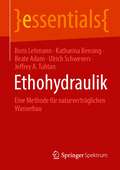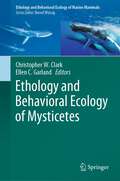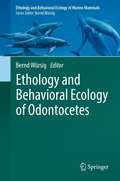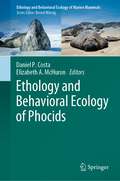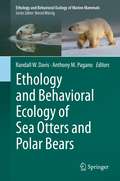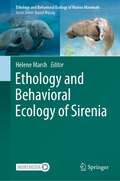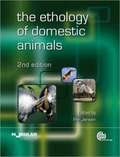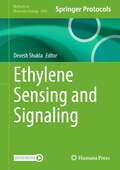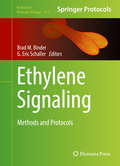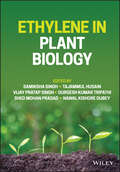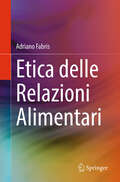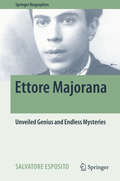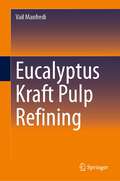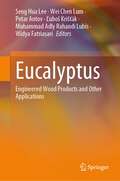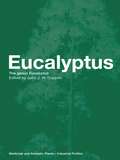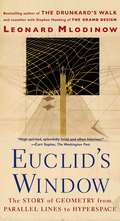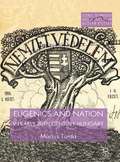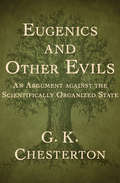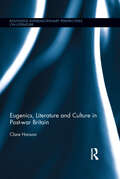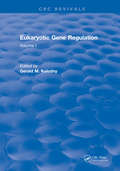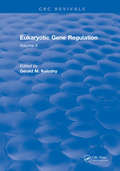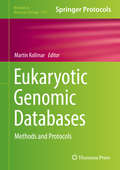- Table View
- List View
Ethohydraulik: Eine Methode für naturverträglichen Wasserbau (essentials)
by Beate Adam Boris Lehmann Ulrich Schwevers Katharina Bensing Jeffrey A. TuhtanEthohydraulik agiert an der Schnittstelle zwischen Verhaltensforschung (Ethologie) und dem Strömungsverhalten (Hydraulik). Ethohydraulische Untersuchungen helfen, das hydraulisch-reaktive Verhalten von Wassertieren zu verstehen. Aus den Befunden lassen sich Grenz- und Richtwerte sowie Gestaltungsvorgaben für die Planung wasserbaulicher Anlagen ableiten. In diesem essential geben die Autoren einen Überblick über die Grundlagen und methodischen Ansätze ethohydraulischer Untersuchungen. Zudem werden Einsatzbereiche und aktuelle Weiterentwicklungen aufgezeigt.
Ethology and Behavioral Ecology of Mysticetes (Ethology and Behavioral Ecology of Marine Mammals)
by Christopher W. Clark Ellen C. GarlandIn this book, an international team of leading marine mammal scientists, with a remarkably diverse set of backgrounds and areas of expertise, lead you through a synthesis of current knowledge on baleen whales. Baleen whales are the largest animals ever to have lived on this planet. They also have the lowest and most intense voices on Earth, most likely evolved to take advantage of ocean acoustic transmission conditions so as to be detectable across ocean basins. Some baleen whales can live to be 150-200 years old. They migrate many thousands of kilometers between feeding and breeding areas. They produce songs and calls that serve as behavioral foundations for establishing, maintaining and expanding their cultural identities. To conclude that we know the behavioral limits of these large brained, long-lived animals would be naïve. As baleen whale scientists, we are still beginning to comprehend the enormous complexities and natural histories of these remarkable animals.Today, the fact that whales sing is known throughout much of the world. This awareness started 50 years ago with the publication and popularization of a collection of humpback song recordings that motivated research into baleen whale behavioral ethology. In this book’s chapters, a reader’s experiences will stretch from learning about baleen whale laryngeal anatomy associated with their different voices to learning about the vast ocean areas over which their voices can be heard and the emerging complexities of their culturally defined societies. These are accompanied by chapters on the fundamental ethological contexts of socializing, migrating, and foraging. Two common themes permeate the book. One theme highlights the phenomenal increase in scientific knowledge achieved through technological advancements. The other theme recognizes the impacts of human-made activities on ocean acoustic environments and the resultant influences on the health and survival of individual whales and their populations. Although the book is intentionally ambitious in its scope, as scientists, we fully recognize that baleen whale science is still in its infancy. Many profound revelations await discovery by cohorts of young, multi-talented explorers, some of whom are stretching their wings in this volume and some of whom are reading these scientific stories for the first time.
Ethology and Behavioral Ecology of Odontocetes (Ethology and Behavioral Ecology of Marine Mammals)
by Bernd WürsigThis book concentrates on the marine mammalian group of Odontocetes, the toothed whales, dolphins, and porpoises. In 23 chapters, a total of 40 authors describe general patterns of ethological concepts of odontocetes in their natural environments, with a strong bent towards behavioral ecology. Examples are given of particularly well-studied species and species groups for which enough data exist, especially from the past 15 years. The aim is to give a modern flavor of present knowledge of ethology and behavior of generally large-brained behaviorally flexible mammals that have evolved quite separately from social mammals on land. As well, the plight of populations and species due to humans is described in multiple chapters, with the goal that an understanding of behavior can help to solve or alleviate at least some human-made problems.
Ethology and Behavioral Ecology of Otariids and the Odobenid (Ethology and Behavioral Ecology of Marine Mammals)
by Claudio Campagna Robert HarcourtThis book is focused on the marine mammalian groups the Otariidae and the Odobenidae, otherwise known as fur seals, sea lions and the walrus. In 30 chapters, more than 60 authors from 30 institutions and 13 nationalities, discuss a broad suite of topics from maternal care and mating behavior, through play, cognition and personality, to adaptation to life in the Anthropocene. The authors explore the behaviors that have allowed these semi-aquatic mammals to thrive in the marine realm. Many populations have recovered following historical decimation, with interesting evolutionary consequences which are explored. Detailed, selected, individual species descriptions are also provided, showcasing the behavioral diversity of this engaging, adaptive and highly successful group of marine mammals.
Ethology and Behavioral Ecology of Phocids (Ethology and Behavioral Ecology of Marine Mammals)
by Daniel P. Costa Elizabeth A. McHuronPhocid (or earless or true) seals are ecologically diverse, occupying habitats from the tropics to the poles in marine and freshwater and feeding on anything from tiny zooplankton to other marine mammals. There are 18 species of phocid seals, the smallest species (ringed seal) is more than 20 times smaller than the largest (southern elephant seal), with marked sexual dimorphism present in some species. This book examines the behavior, ecology, and physiology that allow phocid seals to inhabit such a wide range of habitats. The book is composed of 16 chapters written by 37 authors from 8 countries. The book first describes the general patterns of phocid behavior, followed by descriptions of what is known about well-studied species. We have taken a holistic approach, focusing not only on the behaviors themselves but also on the factors that constrain the expression of behavior and the proximate mechanisms driving behavior. In many cases, the chapters represent collaborations between well-established researchers and early-mid career individuals who bring new perspectives to help carry the field of phocid behavioral ecology well into the future.
Ethology and Behavioral Ecology of Sea Otters and Polar Bears (Ethology and Behavioral Ecology of Marine Mammals)
by Randall W. Davis Anthony M. PaganoSea otters and polar bears are carnivorous marine mammals that still resemble their terrestrial ancestors. Compared with Cetacea (whales and dolphins), Sirenia (dugongs and manatees), and Pinnipedia (seals, sea lions, and walrus), they are less adapted for an aquatic life and the most recently evolved among marine mammals. Sea otters are amphibious but seldom come ashore, and polar bears primarily occur on sea ice or along the shore. When at sea, both species spend most of their time swimming at the surface or making short, shallow dives when foraging or pursuing prey. Indeed, polar bears rarely pursue seals in water. Nevertheless, polar bears are powerful swimmers and will stalk seals from the water. As with many other large carnivores, they are solitary hunters. Although sea otters are gregarious and form aggregations at sea called rafts, they are primarily asocial. Except during mating, the principal interaction among sea otters occurs between a female and offspring during the six-month dependency period. In large carnivores (e.g., wolves and lions) that feed on ungulates, sociality and cooperation are favored because of the need to capture large prey and defend carcasses. Polar bears, which are the largest terrestrial carnivore, are solitary hunters of seals and are neither gregarious nor social. Males and females briefly associate during courtship and mating. During this time, males aggressively compete for females. At other times, males generally avoid each other except for aggregations of males that form while summering on land, and females with cubs avoid males, which are known for infanticide. As with sea otters, the interaction of polar bears outside of mating occurs between a female and her offspring during the 2-3 year dependency period. This interaction is critically important when altricial cubs are born in the winter den. This book provides new insight into the ethology and behavioral ecology of sea otters and polar bears. Each chapter reviews the discoveries of previous studies and integrates recent research using new techniques and technology. The authors also address historic and current anthropogenic challenges for their survival as climate change alters entire marine ecosystems.
Ethology and Behavioral Ecology of Sirenia (Ethology and Behavioral Ecology of Marine Mammals)
by Helene MarshDespite their rich fossil history, there are only four surviving species of sirenians or sea cows, the only fully aquatic herbivorous mammals. The three species of manatees and the dugong live in the coastal waters rivers and lakes of more than 80 tropical and subtropical countries and are all on the IUCN Red List of Threatened Species. This book examines sirenian conservation biology through the lens of their behavioral ecology and ethology. Sirenian feeding, diving, movement, social and reproductive behaviors are reviewed by an international team of scientists from eight countries, with an emphasis on data gathered in the past 15 years.
Ethology of Domestic Animals
by Per JensenModern farm environments are profoundly different from the natural habitats of the ancestors of today's farm animals, and through genetic selection, the appearance and behaviour of the animals themselves have also changed. However, the legacy of the ancestors is still obvious, and some apparently bizarre actions are only possible to understand in the light of the evolutionary history of the species. On the other hand, some of the behaviour we can observe in animals in a modern farm or in a laboratory are not part of the normal, species-specific behaviour at all. They may even indicate that the animal is under stress and that its welfare is poor. Distinguishing between these possibilities is one important goal for applied ethology. This revised and updated edition includes extended coverage of dog behaviour and human-animal interactions as well as novel and intriguing research findings. The issue of animal cognition, central to understanding welfare, has also received a more thorough examination.
Ethylene Sensing and Signaling (Methods in Molecular Biology #2945)
by Devesh ShuklaThis detailed volume presents protocols centered on the sensing and signaling of ethylene, a plant hormone with a vital role in fruit ripening, seed germination, stress adaptation, and a wide array of developmental processes. Beginning with a section on ethylene detection and quantification techniques, including gas chromatography and analysis during hypoxia and pathogen interactions, the book continues by examining the role of ethylene in post-harvest biology and fruit ripening, and associated regulatory mechanisms, including promoter characterization and protein-protein interactions. Further sections explore bioinformatics workflows for unraveling mechanistic roles of ethylene at the cellular and whole-plant levels, as well as the regulatory capacity of ethylene in plant developmental processes, root system modifications, and adaptation to diverse biotic and abiotic stressors. Written for the highly successful Methods in Molecular Biology series, chapters offer readers a hands-on approach to investigate the myriad roles that ethylene plays in plant growth and development. Authoritative and practical, Ethylene Sensing and Signaling serves as a key resource for scientists seeking to employ reliable methodologies in understanding the central function of ethylene in plant biology.
Ethylene Signaling
by Brad M. Binder G. Eric SchallerThis volume provides a collection of protocols aimed toward the study of ethylene signaling in plants. Ethylene Signaling: Methods and Protocols is divided into three sections: ethylene biosynthesis, the signal transduction pathway, and the diverse ethylene responses of dicots and monocots. The chapters in section one discuss techniques for the measurement of activities related to the biosynthetic enzymes ACC synthase and ACC oxidase, the levels of ethylene synthesized by plants, and the treatment of plants with exogenous ethylene. Section two focuses on the analysis of the new membrane-associated proteins involved in the initial perception and transduction of the ethylene signal, such as ethylene receptors, CTR1, and EIN2. The third section covers assays applicable to dicots and monocots, including methods related to the roles of ethylene in germination, growth, abscission, abiotic stress, and defense. Section three also includes information on Arabidopsis mutants and the variety of chemical inhibitors that affect ethylene responses. Written in the highly successful Methods in Molecular Biology series format, chapters include introductions to their respective topics, lists of the necessary materials and reagents, step-by-step, readily reproducible laboratory protocols, and tips on troubleshooting and avoiding known pitfalls. Thorough and comprehensive, Ethylene Signaling: Methods and Protocols is a valuable resource for both experienced and beginner researchers with prior experience in the study of ethylene signaling and for those who are just entering this exciting research field.
Ethylene in Plant Biology
by Nawal Kishore Dubey Samiksha Singh Sheo Mohan Prasad Vijay Pratap Singh Durgesh Kumar Tripathi Tajammul HusainETHYLENE IN PLANT BIOLOGY Comprehensive resource detailing the role of ethylene in plant development regulation, gene regulation, root development, stress tolerance, and more Ethylene in Plant Biology presents ethylene research from leading laboratories around the globe to allow readers to gain strong foundational coverage of the topic and aid in further ethylene research as it pertains to plant biology. The work covers general ideas as well as more specific and technical knowledge, detailing the overall role of ethylene in plant biology as a gaseous plant hormone that has emerged as an important signaling molecule which regulates several steps of a plant’s life cycle. The ideas covered in the work range from discovery of ethylene, to its wide roles in plant growth and development, all the way to niche topics such as stress acclimation. Written by highly qualified authors in fields directly related to plant biology and research, the work is divided into 20 chapters, with each chapter covering a specific facet of ethylene or the interaction between ethylene and plant health. Topics discussed in the text include: Our current understanding of ethylene and fruit ripening, plus the role of ethylene in flower and fruit development Ethylene implications in root development and crosstalk of ethylene with other phytohormones in plant development Ethylene as a multitasking regulator of abscission processes and powerful coordinator of drought responses Mechanisms for ethylene synthesis and homeostasis in plants, along with ethylene and phytohormone crosstalk in plant defense Ethylene and metabolic reprogramming under abiotic stresses, as well as ethylene’s applications in crop improvement For biologists, scientists, researchers, and policy makers in the agriculture and pharmaceutical industries, Ethylene in Plant Biology is a key resource to understand the state of the art in the field and establish a foundation of knowledge that can power future research efforts and practical applications.
Etica delle Relazioni Alimentari
by Adriano FabrisQuesto libro presenta e discute alcuni problemi di fondo che emergono oggi nelle relazioni alimentari e che riguardano i nostri stili di vita. I primi tre capitoli si concentrano sulle questioni che concernono l'alimentazione e sul rapporto con ciò che possiamo o non possiamo mangiare, per motivi etici, religiosi o semplicemente collegati al nostro benessere. Il quarto capitolo tratta dell'atto del bere e del nostro rapporto con l'acqua, nell’ottica della sostenibilità, della giustizia, del corretto uso e dell’equa distribuzione delle risorse idriche. In generale, l’idea che viene sostenuta nel libro è che per gli esseri umani gli atti del mangiare e del bere non dipendono dalla volontà del soggetto, ma si svolgono in contesti di relazione già dati e mettono in gioco, o impediscono, ulteriori relazioni: con altri esseri viventi, con altri esseri umani, con noi stessi. Tali relazioni possono svilupparsi bene oppure male. Se sono attuate male risultano distruttive. Bisogna capire come ciò accade e agire di conseguenza. L’etica ci aiuta a farlo, facendoci riflettere su questi problemi e individuando soluzioni concrete. Scritto per studenti universitari e per studiosi di etiche applicate, il libro è una lettura stimolante e provocatoria anche per un pubblico più ampio.
Etiology and Integrated Management of Economically Important Fungal Diseases of Ornamental Palms (Sustainability in Plant and Crop Protection #16)
by Imran Ul Haq Siddra IjazPalms are monocots, Angiosperms, belonging to the family Palmae (Arecaceae), perennials having woody stems. Palmae (Arecaceae) family comprised of about six subfamilies, 200 genera and 2,700 species that are distributed all over the tropical, subtropical and Mediterranean landscape. Palms are diverse (ecologically and morphologically) group of plants. Ornamental palms are important component of landscape as well as interiorscapes. Additionally, these plants are good source of food, feed and shelter with numerous other commercial benefits. Likewise other trees and crops, landscape and field nurseries of palms are also subjected to various threats of insect pest and diseases (caused by different plant pathogens). Amongst fungal diseases leaf spots, leaf blights, Fusarium wilts, butt rots, bud rots, root rots, lethal yellowing and decline of palms are major growth constraints of palm growth. In developing countries very little attention has been paid on the etiology and management of these fungal diseases on ornamental palms. Accurate diagnosis and reliable management plan of palm fungal diseases usually requires expertise in both modern and advanced plant pathological approaches. Historically it was general belief that plant pathogens are not associated with human diseases. Since 19th century, several clinical reports are available indicating many plant pathogenic fungi (Aspergillus spp., Penicillium spp., Alternaria spp., Trichoderma spp., Fusarium spp., Curvularia spp. and Colletotrichum Spp) as novel agents of human diseases. Besides the association of fungal plant pathogens infecting ornamental palms, harbouring any of earlier mentioned or other fungal species (capable of causing certain diseases in human beings or pets) by the ornamental palms cultivation (either grown indoor or outdoor) is an important area of research to be explored and addressed thoroughly. This book will provide the deep information regarding major fungal diseases of ornamental palms, their symptoms, disease identification, and etiology and management strategies. This book will also provide unique knowledge regarding the ornamental palms harbouring kinds of human fungal pathogens and their practical management at domestic and commercial scale, in order to make cultivation of these plant more beneficial for humans, animals and environment.
Ettore Majorana
by Salvatore EspositoHISTORICAL PRELUDE Ettore Majorana's fame solidly rests on testimonies like the following, from the evocative pen of Giuseppe Cocconi. At the request of Edoardo Amaldi, he wrote from CERN (July 18, 1965): "In January 1938, after having just graduated, I was invited, essen#65533; tially by you, to come to the Institute of Physics at the University in Rome for six months as a teaching assistant, and once I was there I would have the good fortune of joining Fermi, Bernardini (who had been given a chair at Camerino a few months earlier) and Ageno (he, too, a new graduate), in the research of the products of disintegration of /-L "mesons" (at that time called mesotrons or yukons), which are produced by cosmic rays [ . . . ] "It was actually while I was staying with Fermi in the small laboratory on the second floor, absorbed in our work, with Fermi working with a piece of Wilson's chamber (which would help to reveal mesons at the end of their range) on a lathe and me constructing a jalopy for the illumination of the chamber, using the flash produced by the explosion of an aluminum ribbon short circuited on a battery, that Ettore Majorana came in search of Fermi. I was introduced to him and we exchanged few words. A dark face. And that was it.
Eucalyptus Kraft Pulp Refining
by Vail ManfrediThis book presents a brief history of papermaking followed by comments regarding wood as a source of fibers, including its chemical and anatomical characteristics and the influence of these aspects on the quality of the pulp produced. In addition, the author describes the effects of the pulping process, mainly a chemical process, on pulp quality and how these wood characteristics influence both the refining process as the quality of the final paper. The book further provides a broad discussion, based on experimental results, on the contribution of the main operating refining variables and the main strategies that can be used industrially to optimize the operating results. From this evaluation, the parameter that complements the specific edge load theory is identified. This parameter is related to the retention time of the fiber flocs inside the refiner.
Eucalyptus: Engineered Wood Products and Other Applications
by Seng Hua Lee Widya Fatriasari Wei Chen Lum Petar Antov Ľuboš Krišťák Muhammad Adly Rahandi LubisThis book highlights the world distribution of eucalyptus plantations and the recent state of research on the utilization of planted eucalyptus for engineered wood products (EWPs) manufacturing. EWPs such as particleboard, fiberboard, oriented strand board, laminated veneer lumber, plywood, glue-laminated lumber, and cross-laminated lumber are highlighted. Eucalyptus is the main fiber resource for the pulp and paper industries in developed countries. Timber and fibers extracted from eucalyptus have long been utilized for solid wood and manufacturing of medium-density fiberboard. Other uses of eucalyptus such as pulp and paper, fuels, and chemical feedstocks are also discussed. Economic, social, and environmental assessments of eucalyptus products are presented.
Eucalyptus: The Genus Eucalyptus
by John J. W. CoppenEucalyptus, a genus of over 800 species, is a multiproduct crop par excellence. Not only is it grown for timber, pulp and fuelwood, but, as the Aborigines discovered thousands of years ago, it has numerous medicinal and aromatic properties. Since the first commercial distillation of eucalyptus oil 150 years ago, a vast array of eucalyptus-based pro
Euclid’s Window: The Story of Geometry from Parallel Lines to Hyperspace
by Leonard MlodinowMlodinow brilliantly and delightfully leads us on a journey through five revolutions in geometry, from the Greek concept of parallel lines to the latest notions of hyperspace. Here is an altogether new, refreshing, alternative history of math revealing how simple questions anyone might ask about space -- in the living room or in some other galaxy -- have been the hidden engine of the highest achievements in science and technology. Based on Mlodinow's extensive historical research; his studies alongside colleagues such as Richard Feynman and Kip Thorne; and interviews with leading physicists and mathematicians such as Murray Gell-Mann, Edward Witten, and Brian Greene, Euclid's Window is an extraordinary blend of rigorous, authoritative investigation and accessible, good-humored storytelling that makes a stunningly original argument asserting the primacy of geometry. For those who have looked through Euclid's Window, no space, no thing, and no time will ever be quite the same.
Eugenics and Nation in Early 20th Century Hungary
by Marius TurdaIn 1900 Hungary was a regional power in Europe with imperial pretensions; by 1919 it was crippled by profound territorial, social and national transformations. This book chronicles the development of eugenic thinking in early twentieth-century Hungary, examining how eugenics was an integral part of this dynamic historical transformation.
Eugenics and Other Evils: An Argument against the Scientifically Organized State (Mobi Classics Ser.)
by G. K. ChestertonG. K. Chesterton's highly influential treatise on one of the most controversial topics of the early twentieth century When G. K. Chesterton first published Eugenics and Other Evils in 1922, he seemed to be the lone voice of reason against the fashionable concept of selectively breeding a population for "desirable" traits. Though later generations came to associate eugenics with the horrors of the Third Reich, worldwide support for the philosophy was at an all-time high when Chesterton penned this brave and prophetic work. His unique combination of somber analysis and coruscating wit produces an argument too persuasive to ignore. Eugenics and Other Evils showcases Chesterton at the height of his rhetorical powers. His discussion of capitalism, socialism, and the concerns that guide our moral decisions is as pertinent today as the day it was penned. This ebook has been professionally proofread to ensure accuracy and readability on all devices.
Eugenics, Literature, and Culture in Post-war Britain (Routledge Interdisciplinary Perspectives on Literature)
by Clare HansonThis book explores eugenics in its wider social context and in literary representations in post-war Britain. Drawing on a wide range of sources in medicine, social and educational policy, genetics, popular science, science fiction, and literary texts, Hanson tracks the dynamic interactions between eugenic ideas across diverse cultural fields, demonstrating the strength of the eugenic imagination. Challenging assumptions that eugenics was fatally compromised by its association with Nazi atrocities, or that it petered out in the context of changed social attitudes in an egalitarian post-war society, the book demonstrates that eugenic thought not only persisted after 1945, but became more prominent. Throughout, eugenics is defined as a cultural movement, rather than more narrowly as a science, and the study is focused on its border-crossing capacity as a ‘style of thought.’ By tracing the expression of eugenic ideas across disciplinary boundaries and in both high and low culture, this book demonstrates the powerful and pervasive influence of eugenics in the post-war years. Authors visited include Raymond Williams, John Braine, Agatha Christie, Muriel Spark, Anthony Burgess, Doris Lessing, and J.G. Ballard.
Eukaryome Impact on Human Intestine Homeostasis and Mucosal Immunology: Overview of the First Eukaryome Congress at Insitut Pasteur. Paris, October 16–18, 2019.
by Nancy GuillenMultiple demographic or economic parameters contribute to the origin of emerging infections, for example: poverty, urbanization, climate change, conflicts and population migrations. All these factors are a challenge to assess the impact (present and future) of parasitic diseases on public health. The intestine is a major target of these infections; it is a nutrient-rich environment harbouring a complex and dynamic population of 100 trillion microbes: the microbiome. Most researches on the microbiome focus on bacteria, which share the gut ecosystem with a population of uni- and multi cellular eukaryotic organisms that may prey on them. Our interest focuses on the families of eukaryotic microbes inhabiting the intestine, called “intestinal eukaryome”, that include fungi, protists and helminths. Knowledge on the reciprocal influence between the microbiome and the eukaryome, and on their combined impact on homeostasis and intestinal diseases is scanty and can be considered as an important emerging field. Furthermore, the factors that differentiate pathogenic eukaryotes from commensals are still unknown. This book presents an overview of the science presented and discussed in the First Eukaryome Congress held from October 16th to 18th, 2019 at the Pasteur Institute in Paris.This book covers the following topics:Phylogenetic, prevalence, and diversity of intestinal eukaryotic microbes; and their (still enigmatic) historical evolution and potential contributions to mucosal immune homeostasis.Integrative biology to study the molecular cell biology of parasite-host interactions and the multiple parameters underlining the infectious process.The exploitation of tissue engineering and microfluidics to establish three-dimensional (3D) systems that help to understand homeostasis and pathological processes in the human intestine.
Eukaryotic Gene Regulation: Volume I
by Gerald M. KolodnyThe cause of cancer and its many manifestations is at present unknown. Since many of its manifestations, including is control of cell division, appear to represent abnormal patterns of gene expression, studies of the regulation of gene expression nwill provide important insights in the understanding and treatment of cancer. This volume attempts to present some of the recent work on regulation of gene expression in eukaryotic cells.
Eukaryotic Gene Regulation: Volume II
by Gerald M. KolodnyThe cause of cancer and its many manifestations is at present unknown. Since many of its manifestations, including is control of cell division, appear to represent abnormal patterns of gene expression, studies of the regulation of gene expression nwill provide important insights in the understanding and treatment of cancer. This volume attempts to present some of the recent work on regulation of gene expression in eukaryotic cells.
Eukaryotic Genomic Databases: Methods And Protocols (Methods in Molecular Biology #1757)
by Martin KollmarThis volume explores databases containing genome-based data and genome-wide analyses. This book covers databases from all eukaryotic taxa, except plants. The chapters describe database contents and classic use-cases, which assist in accessing eukaryotic genomic data and encouraging comparative genomic research. Written in the highly successful Methods in Molecular Biology series format, chapters include introductions to their respective topics, step-by-step, readily reproducible computational protocols, and tips on troubleshooting and avoiding known pitfalls.Cutting-edge and authoritative, Eukaryotic Genomic Databases: Methods and Protocols is a valuable resource for geneticists and molecular biologists who are interested in the latest eukaryotic genomics data.The chapters 'PomBase: The Scientific Resource for Fission Yeast' and 'The Ensembl Genome Browser: Strategies for Accessing Eukaryotic Genome Data' are available open access under a CC BY 4.0 license via link.springer.com.
